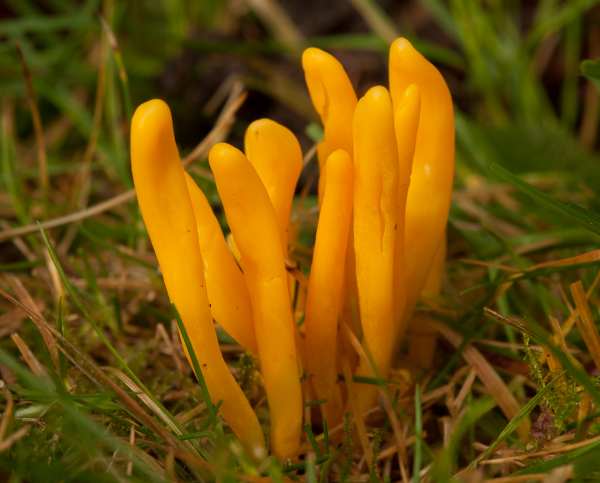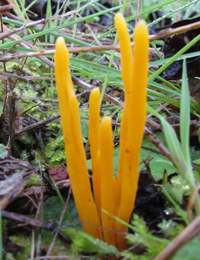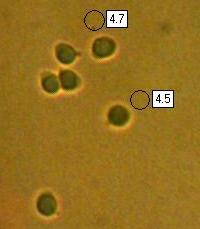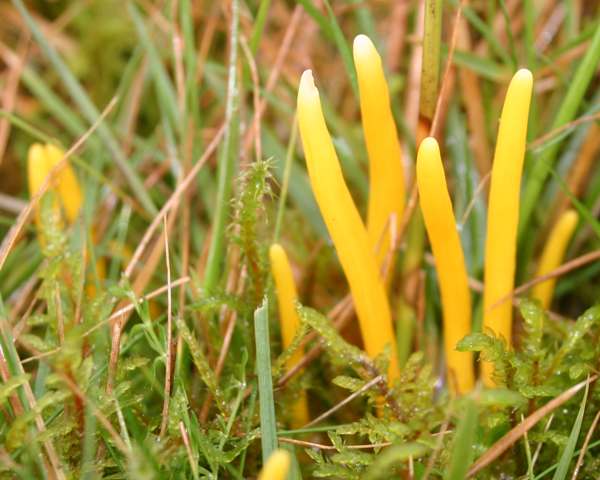Clavulinopsis luteoalba (Rea) Corner - Apricot Club
Phylum: Basidiomycota - Class: Agaricomycetes - Order: Agaricales - Family: Clavariaceae
Distribution - Taxonomic History - Etymology - Identification - Reference Sources

Commonly known as the Apricot Club, Clavulinopsis luteoalba is a relatively common fairy club fungus of short turf meadows and of lawns and parks that are mowed (or grazed) but not treated with herbicides or fertilisers. The colour varies considerably, and some specimens are a deep orange while other are 'apricot' or even paler.
Above: Apricot Clubs photographed in a New Forest garden in 2012 by David Kelly, with whose permission it is shown here.
Distribution
Apricot Club hasbeen recorded throughout Britain. It is also found in Ireland, where there are ,any more records from the north than from the south - almost certainly a reflection of foraying effort rather than distribution. This lovely fairy club is also found in many parts of mainland Europe.

Clavulinopsis luteoalba is reported to be inedible, but in any case because of its insubstantial form and scarceness this is not a species worth seeking if what you need are fungi for the pot.
Taxonomic history
This fairy club fungus was described in 1903 by British mycologist Carlton Rea (1861 - 1946), who gave this grassland fungus the binomial scientific name Clavaria luteoalba. (Rea was one of the founding members of the British Mycological Society and served two terms as its president.) It was another British mycologist, Edred John Henry Corner (1906 - 1996), who in 1950 transferred this species to the genus Clavulinopsis, establishing its currently accepted scientific name as Clavulinopsis luteoalba.
Synonyms of Clavulinopsis luteoalba include Clavaria luteoalba Rea, and Clavulinopsis luteoalba var. latispora Corner.
Etymology
The origin of the generic name is the Latin noun clava meaning a club, with the suffix implying that it looks quite similar to species in the genus Clavulina. The Clavulinopsis genus is closely related to Clavulina and Clavaria, but fungi in the Clavulinopsis group have tougher, less brittle fruitbodies that are solid rather than hollow in structure. The most obvious microscopic difference is that Clavulinopsis species have clamp-connections in the tramal tissues.
The specific epithet luteoalba also comes from Latin and means yellow and white, a reference to the white tips of these yellow clubs.
Identification guide
 |
FruitbodyThe pale-tipped, slender fingers of this glassland fairy club fungus are yellow, often with an orange tinge and of more or less constant diameter, sometimes tapering inwards at the base. The individual clubs are typicaly 1 to 4mm in diameter and 3 to 6cm tall. |
 |
SporesEllipsoidal, smooth, 4.5-8 x 2.5-4.5μm; with a prominent apical pore. Spore printWhite. |
Odour/taste |
Odour slightly musty; taste not distinctive. |
Habitat & Ecological role |
Apricot Club is saprobic and grows from the soil in short grassland. |
Season |
July to November in Britain and Ireland. |
Similar species |
Clavulinopsis fusiformis is similar in size and colour but does not have pale club tips and usually forms much more dense tufts; its clubs are lateraly compressed and sometimes forked, and they are fused at the base. |

Reference Sources
Fascinated by Fungi, 2nd Edition, Pat O'Reilly 2016, reprinted by Coch-y-bonddu Books in 2022.
Dictionary of the Fungi; Paul M. Kirk, Paul F. Cannon, David W. Minter and J. A. Stalpers; CABI, 2008
Taxonomic history and synonym information on these pages is drawn from many sources but in particular from the British Mycological Society's GB Checklist of Fungi.
Fascinated by Fungi. Back by popular demand, Pat O'Reilly's best-selling 450-page hardback book is available now. The latest second edition was republished with a sparkling new cover design in September 2022 by Coch-y-Bonddu Books. Full details and copies are available from the publisher's online bookshop...

